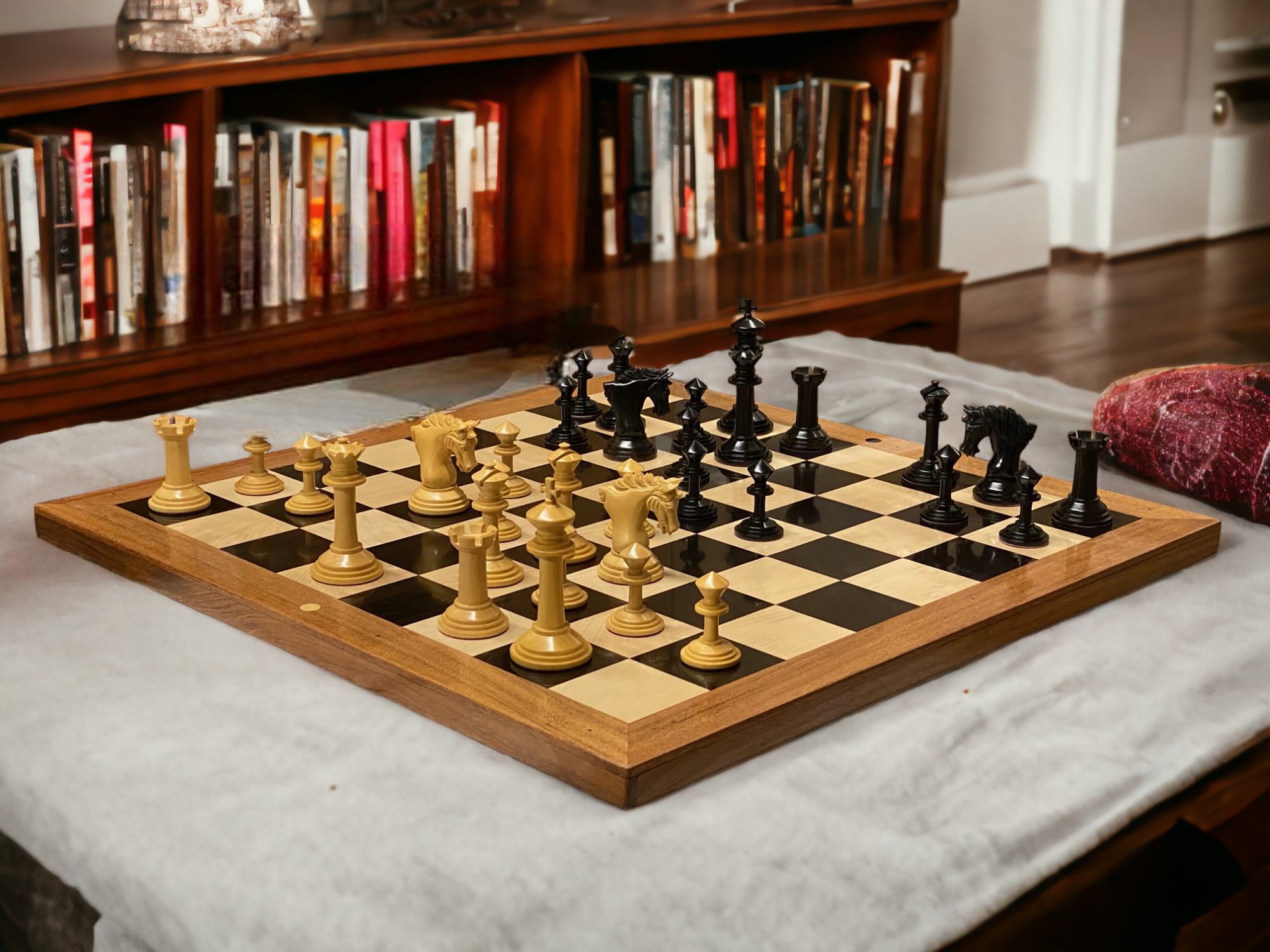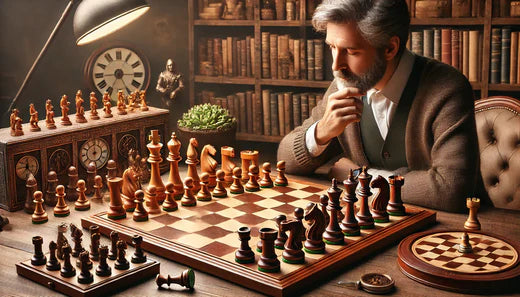A Journey into the Heart of the Game:
Let's dive into the fascinating world of chess! Chess isn't just a game; it's a timeless puzzle that people have loved playing for ages. In the middle of this thinking game is something super important – the chessboard. In this guide, we will explore all about chessboards – where they came from, the different kinds there are, what they're made of, and why they're so important in the chess world.
Imagine the chessboard as the main stage where all the action happens. It's not just a board but a secret map where smart moves and cool strategies unfold. So, get ready to join us on this adventure as we dig deep into the world of chessboards. We'll find out their history, check out the different types you can play on, see what they're made of, and understand why they're a big deal in chess.
Understanding the Chessboard:
The chessboard is the battleground where intellectual warfare unfolds; each moves a carefully calculated step toward victory. Consisting of 64 squares arranged in an 8x8 grid, the chessboard is a visual masterpiece that forms the game's foundation. It is the canvas upon which the drama of checkmates, sacrifices, and strategic maneuvers unfolds.
History of Chessboards:
The fascinating origins of chessboards take us back to ancient India, where the enthralling game of chaturanga first made its mark on an 8x8 board. This early version of chess was a precursor to the strategic battles we know today, and the board played a crucial role in shaping the game's foundations.
As the winds of time carried the game from India to Persia and then to Europe, the design of the chessboard underwent an intriguing evolution. The classic pattern of alternating light and dark squares emerged as the standard. This distinctive checkerboard layout wasn't just about looks; it served a dual purpose, offering players aesthetic appeal and functional clarity.
The alternating pattern of light and dark squares on the chessboard became more than a visual treat – it became a universal language for chess enthusiasts worldwide. This standardized design highlighted the board's beauty and made it easy to understand the game. Every square became a canvas for strategic moves, and the timeless appeal of this pattern endures in the chessboards we use today.
The journey of the chessboard from ancient India to Persia and Europe reflects more than just geographical transitions. It symbolizes the evolution of a game and its playing surface, where each square tells a story of strategic innovation and cultural exchange. The classic design that originated centuries ago is a hallmark of chess, uniting players across time and space with its aesthetic charm and practical functionality.
Types of Chessboards:
Chessboards come in various types, catering to different preferences and playing styles. Traditional wooden chessboards exude elegance and are often preferred by purists. Modern options include vinyl and silicone boards, which are more portable and resistant to wear. Magnetic chessboards are ideal for on-the-go play, ensuring the pieces stay in place during travel.
Materials Used in Chessboards:
1. Wood:
- Popularity: Wood is a timeless and widely favored material for crafting chessboards.
- Varieties: Rosewood, ebony, and maple are among the preferred wood choices, each with unique textures, colors, and finishes.
- Aesthetics: Wood's natural grain and patterns contribute to the classic and elegant appearance of wooden chessboards.
- Durability: Well-crafted wooden boards are known for their durability, ensuring longevity and withstanding the rigors of frequent gameplay.
2. Acrylic:
- Modern Appeal: Acrylic has gained popularity for its modern and sleek aesthetic, attracting chess enthusiasts looking for a contemporary touch.
- Visual Impact: The transparent nature of acrylic allows for creative and artistic designs, making it visually striking and unique.
- Versatility: Acrylic chessboards are often lightweight and versatile, suitable for various settings and occasions.
3. Glass:
- Contemporary Elegance: Glass chessboards exude a contemporary and sophisticated charm, making them a choice for those seeking a stylish addition to their game room.
- Visual Transparency: The transparent quality of glass adds a layer of visual interest, especially when paired with intricately designed chess pieces.
- Maintenance: Glass boards are generally easy to clean and maintain, enhancing their appeal for players looking for convenience.
Other Composites:
- Innovation: Some chessboards utilize innovative materials or composites, blending modernity and practicality.
- Customization: Manufacturers often experiment with materials to create chessboards with unique designs, allowing for customization and personalization.
- Durability and Weight: Depending on the specific composite, these boards may balance durability and weight, catering to diverse player preferences.
5. Metal:
- Modern and Industrial: Metal chessboards, often made of materials like aluminum or brass, appeal to those seeking a modern or industrial aesthetic.
- Sturdiness: Metal boards are known for their sturdiness, providing a robust playing surface that can withstand the test of time.
- Artistic Expressions: Some metal boards showcase intricate engravings or artistic expressions, adding an extra layer of sophistication.
Significance of Chessboards in Strategy:
The chessboard is not merely a playing surface; it is a strategic tool that influences the course of the game. The distinctive pattern of light and dark squares aids players in visualizing moves and planning their tactics. Understanding the importance of controlling the center and exploiting the board's geometry is crucial for any aspiring chess player.
Chessboards in Competitive Play:
The type of chessboard used in competitive chess can impact a player's performance. Tournaments often standardize equipment to ensure a level playing field. The familiar 8x8 grid and the contrast between light and dark squares contribute to fair competition, allowing players to focus on their skills rather than adjusting to unfamiliar boards.
Choosing the Right Chessboard:
Selecting the right chessboard is a personal decision influenced by individual preferences and playing style. Wooden boards exude a classic charm, while modern materials offer practical advantages. Consider board size, square dimensions, and overall aesthetics when choosing. A well-chosen chessboard enhances the overall chess experience, making each game visually pleasing and intellectually stimulating.
Maintaining Your Chessboard:
Proper care and maintenance are essential to preserve the beauty and functionality of your chessboard. Wooden boards require periodic cleaning and polishing to prevent damage and maintain luster. Vinyl and silicone boards are easy to clean, making them suitable for frequent use. Investing time in caring for your chessboard ensures it remains reliable throughout countless games.
Chessboards in Art and Culture:
Beyond their utility in the game, chessboards have permeated art and culture throughout history. Artists have depicted chessboards in paintings and sculptures, symbolizing the intellectual pursuits and strategic thinking associated with the game. Chessboards also find a place in literature, movies, and other forms of popular culture, emphasizing their enduring significance.



